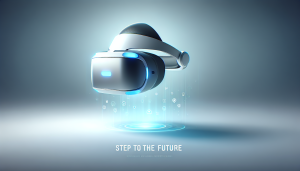
VistaAR Revolutionizes iOS with Groundbreaking Augmented and Virtual Reality Experience
The Rise of “VistaAR”: A Breakthrough Augmented and Virtual Reality Experience on iOS
In the ever-evolving landscape of virtual reality (VR), the intersection with mobile platforms has always been a fascinating battleground. Recently, a particularly exciting development has emerged for iOS users that promises to redefine what we expect from VR on our devices. The release of “VistaAR,” a cutting-edge application combining augmented reality (AR) and virtual reality elements on iOS, is sparking considerable buzz—and for good reason.
Developed by a visionary team of VR enthusiasts and software engineers, VistaAR marks a significant leap forward by harnessing the latest iOS hardware capabilities coupled with Apple’s robust ARKit framework. This article dives deep into what makes VistaAR a standout release, its innovative features, and why it’s poised to impact the VR landscape significantly.

What Is VistaAR?
VistaAR is a hybrid virtual reality and augmented reality app designed exclusively for iOS devices. Unlike traditional VR apps that rely heavily on dedicated headsets or cumbersome equipment, VistaAR provides an immersive, high-fidelity experience through a remarkably lightweight setup. Utilizing the iPhone’s LiDAR scanner and the A-series chipset’s powerful neural engine, the application can seamlessly blend virtual 3D environments with the real world, visible through the phone’s camera.
This is not merely another AR or VR app; it is the convergence of the two, offering users the flexibility to switch between full immersive VR scenes and sophisticated mixed-reality overlays within their immediate surroundings. For the first time, iOS users can explore virtual landscapes or interact with virtual objects as if they were tangible, all in one unified experience.
The Hardware and Software Magic Behind VistaAR
One of the core reasons VistaAR feels revolutionary is due to Apple’s recent hardware innovations. The LiDAR scanner on the latest iPhone and iPad Pro models allows for precise depth mapping with millimeter accuracy, feeding data directly into VistaAR’s rendering engine. This mapping capability creates a robust digital mesh of the user’s environment, enabling natural object placement and interaction within complex spaces.
Moreover, Apple’s A14 and subsequent chips provide immensely powerful graphics and machine learning capabilities. VistaAR leverages CoreML and Metal—invaluable tools for developers—to run real-time scene analysis, spatial audio processing, and photorealistic rendering at a silky smooth frame rate that keeps users comfortably immersed without the jitter or visual lag that traditionally plagues mobile VR experiences.
VistaAR’s developers have also optimized the app for the latest iOS updates, ensuring smooth compatibility and integration with Apple’s ecosystem, including seamless support for the upcoming Vision Pro headset, which Apple has widely teased as the future of spatial computing.
Innovative Features Making Waves
The hallmark of VistaAR is its multifaceted approach to immersion:
1. **Dynamic Environmental Anchoring:** Using LiDAR, VistaAR anchors virtual objects precisely in the physical world. Imagine arranging furniture virtually in your living room or experiencing a virtual aquarium swimming right on your kitchen table. This feature is pivotal for interior designers, hobbyists, and gamers who want grounded, responsive AR experiences.
2. **Full 360º Virtual Environments:** While AR features add augmentation, VistaAR’s VR mode transports users into isolated digital worlds that can be navigated with intuitive touch and motion controls. The high-resolution textures and detailed lighting effects rival some standalone VR headsets despite running purely on iOS hardware.
3. **Multi-User Connectivity:** Understanding the importance of shared experiences, VistaAR supports simultaneous multi-user sessions over Wi-Fi or 5G connections. iOS users can join friends in the same virtual environment no matter their physical location—a fun twist making social VR more accessible.
4. **Developer-Friendly SDK:** Beyond consumer excitement, VistaAR’s public SDK opens doors for developers to craft bespoke AR/VR content optimized for iOS, democratizing access to immersive technology and encouraging innovation within the Apple app ecosystem.
Why VistaAR Matters in the Virtual Reality Evolution
Virtual reality has long been dominated by bulky headsets and tethered systems, primarily on PC or console platforms. Mobile VR often suffered from low graphical fidelity and limited interactivity. VistaAR’s arrival demonstrates how far mobile VR—and specifically iOS VR—has come by combining Apple’s hardware strengths with forward-thinking software design.
VistaAR obliterates many preconceived limitations. It paves the way for accessible yet compelling VR/AR experiences on devices people carry every day. This shift has enormous implications for industries like education, gaming, healthcare, and remote collaboration:
– **Education:** Picture students exploring virtual historical sites in 360º or interacting with 3D biology models in their classroom—all powered by their iPhones or iPads.
– **Gaming:** VistaAR offers developers a platform to create immersive games that seamlessly alternate between AR and VR, delivering richer storytelling and gameplay.
– **Healthcare:** Therapists can design exposure therapy sessions within customized virtual environments, while surgeons may rehearse complex procedures with spatial AR models.
– **Remote Collaboration:** The multi-user features foster natural teamwork in virtual workspaces, allowing iOS users to brainstorm, prototype, or present ideas in a shared immersive setting.
In each case, VistaAR highlights the inherent strength of virtual reality as more than a novelty—positioning it as an indispensable tool reshaping how we work, learn, and play.
Expert Perspectives & Industry Impact
Isaac Turner, a renowned VR developer and early VistaAR beta tester, shares his excitement: “VistaAR bridges the gap between virtual and physical worlds in a way I haven’t seen from any mobile VR app before. The precision of LiDAR integration combined with high-performance rendering makes it feel like holding the future in your hand.”
Furthermore, industry analysts note that platforms like VistaAR help Apple maintain its competitive edge in spatial computing. With companies like Meta and Sony heavily investing in dedicated hardware ecosystems, Apple’s strength lies in democratizing access through versatile mobile devices augmented by software innovations.
It’s a strategic move that could accelerate mainstream adoption of virtual reality on personal devices, bypassing the need for expensive headsets and complicated setups. Since the majority of users already have iPhones or iPads, VistaAR’s debut may be a catalyst for mass-market VR engagement.
Conclusion: VistaAR’s Role in the Future of iOS VR
As an iOS VR enthusiast, it’s thrilling to witness an app like VistaAR reshape the contours of virtual reality on mobile platforms. It cleverly exploits Apple’s hardware strengths and modern software tools, delivering a hybrid experience that feels remarkably immersive, accessible, and versatile.
Virtual reality is no longer confined to bulky helmets or niche gamers—it’s becoming a part of everyday life, thanks to innovations like VistaAR on iOS. Whether for work or play, education or entertainment, this development signals a bright horizon where VR tech integrates seamlessly with daily routines.
For those eager to explore the possibilities of virtual reality without investing in expensive external hardware, VistaAR provides a compelling reason to dive into the future today. Keep an eye on this app—it’s poised to be a landmark moment in the evolution of VR experiences on iOS and beyond.

